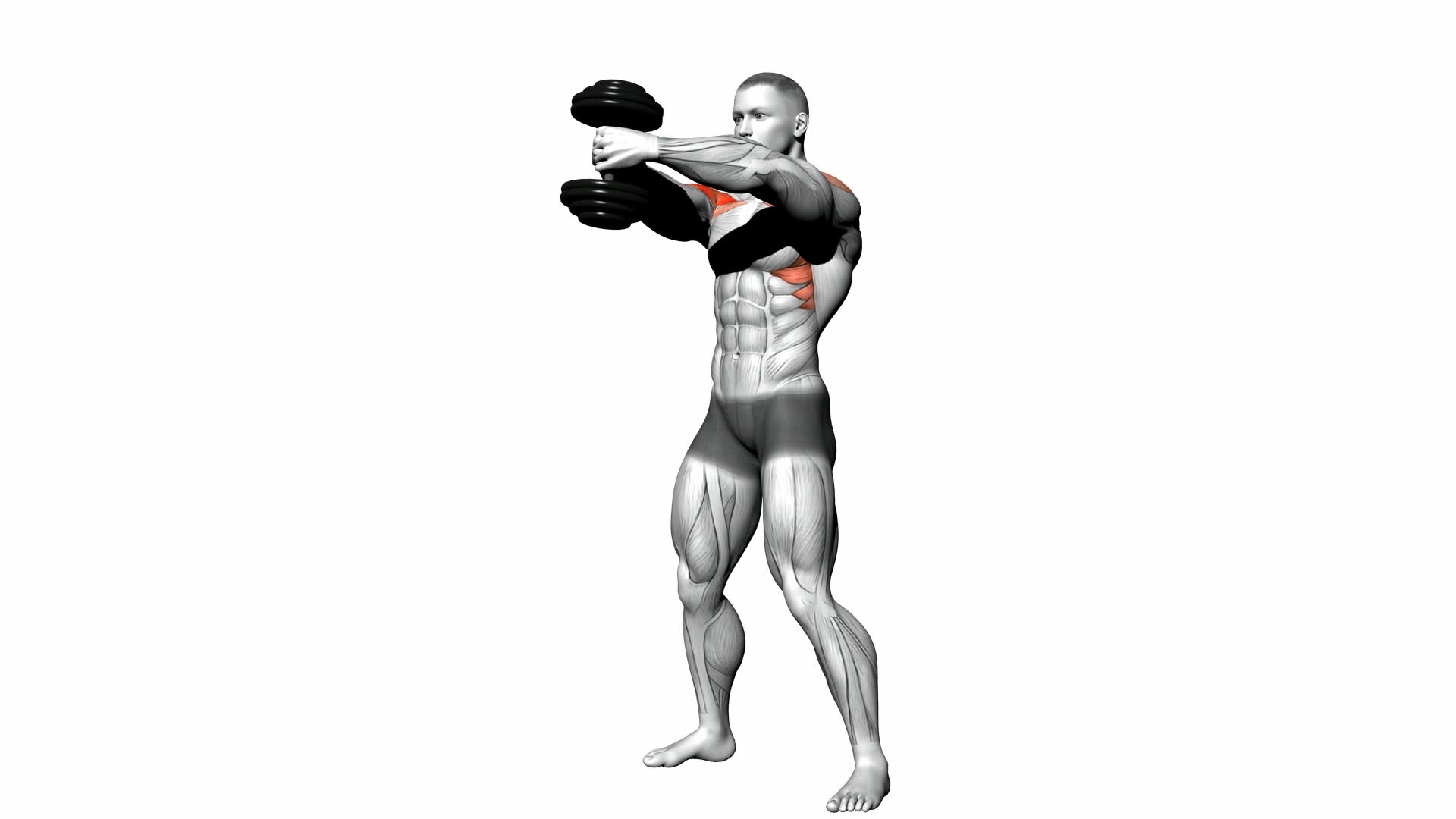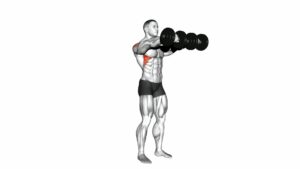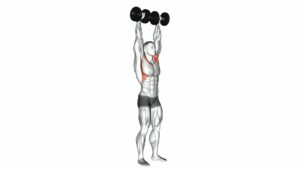Dumbbell Front Raise (version 2) – Video Exercise Guide & Tips

Looking to tone your shoulders and upper body? Check out this video exercise guide and tips for the Dumbbell Front Raise (version 2).
Watch This Exercise Video
You'll learn how to perform this exercise with proper form and technique, as well as common mistakes to avoid. Discover variations and modifications to customize your workout, and get tips for increasing the difficulty.
Start incorporating the Dumbbell Front Raise into your routine for a stronger and more sculpted upper body.
Let's get lifting!
Key Takeaways
- Dumbbell Front Raise targets anterior deltoids, lateral deltoids, and upper pectoralis major
- Proper form and technique include maintaining a stable core, standing with feet shoulder-width apart, keeping back straight and shoulders relaxed, and engaging core muscles
- Common mistakes to avoid include using too much weight, swinging the dumbbells, lifting the dumbbells too high, not maintaining proper form and technique, and failing to engage shoulder muscles
- Variations and modifications include different grip options, adjusting weight levels, incorporating resistance bands, exploring different ranges of motion, and adding pauses or tempo changes
Benefits of Dumbbell Front Raise (version 2)
You will experience numerous benefits when performing the Dumbbell Front Raise (version 2). This exercise primarily targets the anterior deltoids, which are the muscles located at the front of your shoulders. Along with the anterior deltoids, other muscles worked include the lateral deltoids, which are responsible for shoulder abduction, and the upper pectoralis major, which assists in shoulder flexion.
By regularly incorporating the Dumbbell Front Raise (version 2) into your workout routine, you can expect increased shoulder strength. This exercise specifically targets the muscles that contribute to shoulder stability and mobility. As you progressively increase the weight of the dumbbells, you'll challenge and strengthen these muscles, leading to improved overall shoulder strength.
Having strong shoulders is essential for performing everyday activities and participating in various sports. Increased shoulder strength can enhance your performance in activities that involve pushing, pulling, lifting, or throwing. It can also help prevent shoulder injuries and improve your posture.
Proper Form and Technique
To ensure proper execution of the Dumbbell Front Raise (version 2), maintain a stable and engaged core throughout the exercise. This is essential for improving shoulder strength and preventing shoulder injuries.
When performing the Dumbbell Front Raise (version 2), start by standing with your feet shoulder-width apart and a dumbbell in each hand. Keep your back straight and your shoulders relaxed. Engage your core muscles by pulling your belly button towards your spine. This will help stabilize your body and support your shoulders throughout the exercise.
Next, exhale and slowly lift the dumbbells in front of you, keeping your arms straight and your palms facing down. Lift the dumbbells to shoulder height, making sure to control the movement and avoid any swinging or jerking motions. Pause briefly at the top of the movement, then inhale and slowly lower the dumbbells back down to the starting position.
Remember to maintain proper form and technique throughout the exercise. Avoid using momentum to lift the dumbbells and focus on engaging your shoulder muscles. By practicing good form and technique, you can effectively improve shoulder strength and reduce the risk of shoulder injuries.
Common Mistakes to Avoid
Avoiding proper form and technique can lead to common mistakes in the execution of the Dumbbell Front Raise (version 2). It's crucial to be aware of these mistakes to ensure you get the most out of your workout and avoid any potential injuries.
One common mistake is using too much weight. It's important to start with a weight that you can control throughout the movement. Using excessive weight can lead to improper form and compromise the effectiveness of the exercise.
Another mistake is swinging the dumbbells. This often occurs when individuals try to lift weights that are too heavy for them. To avoid this, focus on using controlled movements and engaging the targeted muscles.
Lastly, avoid lifting the dumbbells too high. While it may be tempting to lift the weights above shoulder level, doing so can put unnecessary strain on your shoulders and increase the risk of injury. Instead, aim to lift the dumbbells until your arms are parallel to the floor.
By avoiding these common mistakes and focusing on proper technique, you can maximize the benefits of the Dumbbell Front Raise (version 2).
Now, let's explore some variations and modifications to further enhance your workout.
Variations and Modifications
Let's explore some variations and modifications you can make to the dumbbell front raise exercise.
First, consider different grip options, such as using an overhand or underhand grip, to target different muscle groups.
Secondly, you can adjust the weight levels by using lighter or heavier dumbbells to challenge yourself or modify the intensity.
Lastly, incorporating resistance bands into the exercise can provide additional resistance and add variety to your workout routine.
Different Grip Options
Choose from three different grip options to add variety and target different muscles during the Dumbbell Front Raise exercise. The grip you choose can impact not only the muscles worked, but also grip strength and shoulder stability.
The first grip option is the standard grip, where you hold the dumbbells with your palms facing down. This grip primarily targets the anterior deltoids, which are the front muscles of the shoulders. It also engages the biceps and forearms, improving your grip strength.
The second grip option is the neutral grip, where your palms face each other. This grip emphasizes the medial deltoids, which are the middle muscles of the shoulders. It also provides more stability to the shoulders, making it a great option for individuals with shoulder issues.
The third grip option is the pronated grip, where your palms face up. This grip puts more emphasis on the posterior deltoids, which are the rear muscles of the shoulders. It also engages the muscles of the upper back, improving shoulder stability.
By incorporating these different grip options into your Dumbbell Front Raise routine, you can target a variety of muscles and enhance both grip strength and shoulder stability.
Now, let's move on to the next section and explore how to adjust weight levels for this exercise.
Adjusting Weight Levels
To continue targeting different muscles and improving grip strength and shoulder stability, you can modify the weight levels for the Dumbbell Front Raise exercise. Adjusting the weight levels allows for progressive overload, which is essential for muscle activation and growth. By increasing the weight gradually, you challenge your muscles more, forcing them to adapt and become stronger.
Start with a weight that allows you to perform the exercise with proper form and control. As you become more comfortable and confident, gradually increase the weight to continue challenging your muscles. Remember to listen to your body and avoid using weights that are too heavy, as this can lead to injury.
Now, let's explore another way to add resistance to your Dumbbell Front Raise exercise by using resistance bands.
Using Resistance Bands
You can easily incorporate resistance bands into your Dumbbell Front Raise exercise routine by regularly using them for added challenge and variety. Resistance band exercises are a great way to enhance your shoulder strength training.
To perform the Dumbbell Front Raise with resistance bands, start by standing on the center of the band with your feet shoulder-width apart. Hold the ends of the band with your palms facing down and raise your arms straight in front of you, keeping them parallel to the floor. Slowly lower them back down and repeat for the desired number of repetitions.
The resistance provided by the bands will engage your muscles in a different way, helping to improve your shoulder strength and stability. Incorporating resistance bands into your routine can help to prevent plateaus and keep your workouts challenging and effective.
Tips for Increasing Difficulty
To enhance the challenge of the dumbbell front raise exercise, gradually increase the weight of the dumbbells you're using. Increasing the intensity of your workouts is crucial for making progress and achieving your fitness goals. By progressively overloading your muscles, you force them to adapt and become stronger over time.
When it comes to the dumbbell front raise, increasing the weight of the dumbbells will challenge your shoulder muscles even more. Start by selecting a weight that allows you to perform the exercise with proper form and without straining. As you become comfortable with that weight, gradually increase it to continue challenging yourself.
It's important to note that you should never sacrifice proper form for heavier weights. Maintaining proper technique is essential for targeting the correct muscles and preventing injuries. If you find that you're struggling to maintain proper form with the increased weight, it may be a sign that you need to reduce the weight slightly and focus on building up strength gradually.
Sample Dumbbell Front Raise Workout Routine
To progress from the previous subtopic of increasing the difficulty of the dumbbell front raise exercise, let's now explore a sample workout routine that incorporates this exercise. Here is a four-step routine that will help you increase the intensity of your dumbbell front raise workout:
- Start with a warm-up: Before diving into the main workout, it's important to warm up your muscles. Spend about five minutes performing light cardio exercises like jogging or jumping jacks to get your blood flowing and prepare your body for the upcoming workout.
- Perform three sets of dumbbell front raises: Start with a weight that challenges you but allows you to maintain proper form. Perform 10-12 reps for each set, focusing on keeping your core engaged and your shoulder blades pulled back throughout the movement.
- Increase the weight gradually: As you get comfortable with the exercise, gradually increase the weight of the dumbbells. This will continue to challenge your muscles and help you build strength over time.
- Incorporate modifications: To further increase the workout intensity, you can try different modifications of the dumbbell front raise. For example, you can perform the exercise on an unstable surface like a Bosu ball or incorporate a slight pause at the top of the movement to increase time under tension.
Frequently Asked Questions
Can Dumbbell Front Raises Help Improve Shoulder Strength and Stability?
Dumbbell front raises are excellent shoulder exercises that can help improve your shoulder strength and stability. By incorporating dumbbell front raises into your workout routine, you can target the muscles in your shoulders, including the anterior deltoids.
This exercise can also help improve your posture and enhance your overall upper body strength. So, if you're looking for an effective way to strengthen and stabilize your shoulders, dumbbell front raises offer numerous benefits.
Are There Any Alternatives to Dumbbell Front Raises for Targeting the Front Shoulder Muscles?
Looking for alternatives to dumbbell front raises for targeting your front shoulder muscles? There are a few options you can try.
Barbell front raises, cable front raises, and resistance band front raises are all effective alternatives. Incorporating front raises into your shoulder workout can help improve shoulder strength and stability.
It targets the anterior deltoid, which is crucial for shoulder mobility and overall upper body strength.
How Many Sets and Reps Should I Do for Dumbbell Front Raises to See Results?
To see results from dumbbell front raises, you should aim for an optimal training frequency. This means doing the exercise consistently, but also allowing enough time for rest and recovery.
As for sets and reps, it's generally recommended to start with 3-4 sets of 8-12 reps. This will target your front shoulder muscles effectively and promote muscle growth.
Remember to use proper form and gradually increase the weight as you get stronger.
Can Dumbbell Front Raises Help Reduce Shoulder Impingement or Pain?
Dumbbell front raises vs. shoulder presses: which is more effective?
Can dumbbell front raises be incorporated into a shoulder rehab program?
Dumbbell front raises can help reduce shoulder impingement or pain by strengthening the muscles surrounding the shoulder joint. This exercise specifically targets the anterior deltoid, which helps to stabilize and support the shoulder.
While both dumbbell front raises and shoulder presses are effective exercises, it's important to consult with a healthcare professional or physical therapist to determine the best approach for your specific shoulder condition.
Are There Any Precautions or Contraindications for Performing Dumbbell Front Raises?
When performing dumbbell front raises, it's important to be aware of any precautions or contraindications. Before starting this exercise, consult a healthcare professional to ensure it's safe for you.
Some common precautions include avoiding excessive weight, maintaining proper form, and not performing the exercise if you have any shoulder or neck injuries.
However, when done correctly, dumbbell front raises can offer benefits like strengthening the shoulders and improving posture.
Conclusion
In conclusion, the Dumbbell Front Raise (version 2) is a highly effective exercise for targeting and strengthening the shoulders. By following proper form and technique, avoiding common mistakes, and incorporating variations and modifications, you can maximize the benefits of this exercise.
Additionally, by gradually increasing the difficulty level and incorporating it into a well-rounded workout routine, you can achieve great results in terms of shoulder strength and definition.
Keep practicing and pushing yourself to reach new heights with this exercise.

Author
Years ago, the spark of my life’s passion ignited in my mind the moment I stepped into the local gym for the first time. The inaugural bead of perspiration, the initial endeavor, the very first surge of endorphins, and a sense of pride that washed over me post-workout marked the beginning of my deep-seated interest in strength sports, fitness, and sports nutrition. This very curiosity blossomed rapidly into a profound fascination, propelling me to earn a Master’s degree in Physical Education from the Academy of Physical Education in Krakow, followed by a Sports Manager diploma from the Jagiellonian University. My journey of growth led me to gain more specialized qualifications, such as being a certified personal trainer with a focus on sports dietetics, a lifeguard, and an instructor for wellness and corrective gymnastics. Theoretical knowledge paired seamlessly with practical experience, reinforcing my belief that the transformation of individuals under my guidance was also a reflection of my personal growth. This belief holds true even today. Each day, I strive to push the boundaries and explore new realms. These realms gently elevate me to greater heights. The unique combination of passion for my field and the continuous quest for growth fuels my drive to break new ground.







